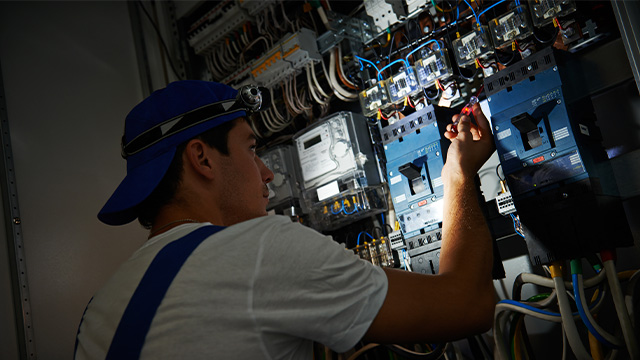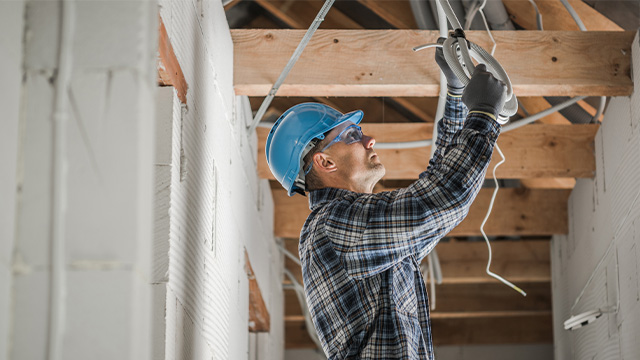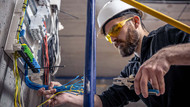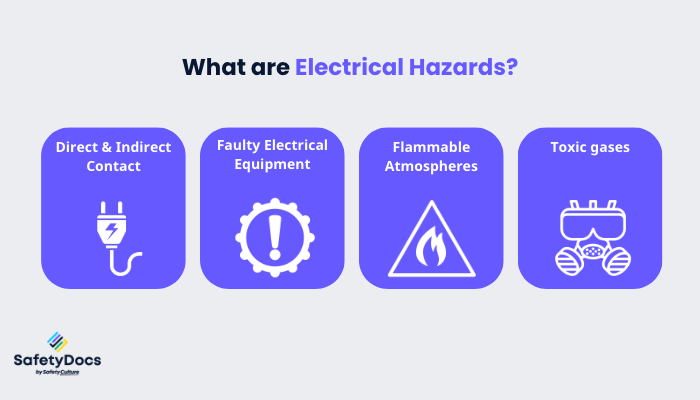In 2021-2022, eight incidents resulted in nine fatalities due to electrical causes in Australia and New Zealand. The rate of deaths per million people (DMP) was 0.29, an increase of 0.26 DMP compared to the previous year. Knowing the risks associated with electricity and how to manage those risks is essential for any workplace.
This article will dive into the different risks related to electrical work in Australia. We'll look at the current regulations and standards, what end-users can do to ensure other electrical equipment in their workplace is safe from electrical incidents, and how to manage potential risks.
What is Electrical Work
Work Health and Safety (WHS) Regulations define electrical work in Australia. These regulations outline the scope of electrical work and includes the following activities:
- Connecting electricity supply wiring to electrical equipment
- Disconnecting electricity supply wiring from electrical equipment
- Installing, removing, adding, testing, replacing, repairing, altering, or maintaining electrical equipment or an electrical installation
- Work that involves connecting electrical equipment to an electricity supply using a flexible cord plug and socket outlet
Electrical work does not include connecting equipment via a plug and socket outlet, working on non-electrical components without exposure to electrical risk, or replacing items that don't require expertise in electrical work (e.g., fuses or light bulbs).
What are Electrical Hazards?
Every year in Australia, approximately 30 people are injured or killed due to electrical accidents. Exposure to even brief contact with electricity at 50 volts for direct current (V DC) can pose significant health and safety risks for an individual. Electrical hazards can pose a threat to people's safety, and these risks can cause death, serious injury, or shock. Here are some common electrical hazards and risks in Australia:
- Direct and Indirect Contact: Electrical risks can be direct or indirect contact with live parts, which can cause electric shock and burns.
- Faulty Electrical Equipment: Workers using electricity may not be the only ones at risk. Injuries or worse yet, death, can result from fires caused by faulty equipment or substandard electrical installations.
- Flammable or Explosive Atmospheres: Electrical risks can arise in potentially flammable or explosive atmospheres, such as in a spray paint booth, where fire or explosion could be the source of ignition.
- Toxic gases: Some types of electrical work can produce poisonous gases such as carbon monoxide that can cause serious health consequences.
Legal Requirements and Standards in Australia for Electrical Safety
Each Australian state and territory regulate the legal requirements and standards for electrical safety in Australia, and New Zealand, separately. However, some general guidelines apply across the board. Here are some of the essential legal requirements and standards for electrical safety in Australia:
AS/NZS 3820:2020 Essential safety requirements for electrical equipment
AS/NZS 3820 is the joint Australian and New Zealand standards for essential safety requirements of electrical equipment. The objective of this standard is to provide a set of criteria for the safety of electrical equipment. Here are some key points about AS/NZS 3820:
- AS/NZS 3820 is one part of the framework used by Electrical Safety Regulatory Authorities to ensure electrical equipment suppliers know the requirements to ensure the equipment they supply is electrically safe.
- The standard provides the criteria for the safety of electrical equipment, including design, construction, testing electrical equipment, and marking requirements.
- Compliance with AS/NZS 3820 is necessary for electrical equipment to be recognised as safe.
Electrical Equipment Safety System (EESS)
The Electrical Equipment Safety System is used in Queensland, Victoria, Western Australia, and Tasmania to regulate the safety of household electrical equipment. South Australia, Northern Territory, and the Australian Capital Territory are transitioning to the EESS. The pre-market requirements include a certification process for specific electrical equipment, which must meet Australian/New Zealand electrical safety standards and be electrically safe.
AS/NZS 3760:2022 In-service safety inspection and testing of electrical equipment and RCDs
AS/NZS 3760 specifies the generally observed safety inspection and maintenance standards for single and polyphase portable electrical equipment and machinery. It is a joint Australian and New Zealand Standard that provides guidelines and procedures for the safety inspection, testing, and tagging of all portable equipment and electrical appliances. It helps to minimise the risk of electrical accidents in the workplace and other environments where workers use electrical equipment.
The standard covers various electrical equipment, including 240V, 3-phase, and low-voltage devices. It outlines the frequency of inspections, the qualifications required of those performing the tests, and the documentation needed to demonstrate compliance with the standard.
Electrical Safety Act 2002
The Electrical Safety Act 2002 is a law in Queensland, Australia, that outlines what electrical workers must do to prevent people from being killed or injured and property destroyed or damaged by electricity. This law outlines what can help prevent death, injury, and destroyed or damaged properties by electricity. Queensland's electrical safety legal framework includes the Electrical Safety Act 2002, the Electrical Safety Regulation 2013, and codes of practice.
Licensing
The licensing requirements for electrical work in Australia vary depending on the state or territory. Here are some examples of licensing requirements in different parts of Australia:
- Western Australia: An electrical worker's license is required for electrical work if it's not on the list of regulations. The Electrical Licensing Board issues the permits for contracting and installation work.
- New South Wales: Construction professionals, builders, and tradespeople must be licensed to undertake residential and commercial building work. Specifications for licensing differ based on the kind of work and level of responsibility for the worker. For instance, a general residential building license may not authorise supervisors or specialised work.
- Queensland: To ensure safety and quality, the Electrical Safety Office issues licenses to electrical contractors and electricians as only they should perform electrical work.
- Victoria: Energy Safe Victoria licenses and registers all electricians and electrical tradespersons. Holding an A-Grade license permits electrical installation work in Victoria without supervision.
These standards and requirements are one of the many ways that Australia is ensuring the safety of electrical systems and equipment. By following these regulations, employers and workers can ensure their workplace is safe from electrical hazards.

Managing Electrical Risks in the Workplace
Aside from compliance with legal standards, employers must also take steps to identify and manage electrical risks associated with their operations. This involves the following:
Risk Assessment and Hazard Identification
Conducting a thorough risk assessment is a fundamental step in managing electrical risks. It involves identifying potential hazards and evaluating the associated risks. A comprehensive assessment enables organisations to prioritise control measures effectively and allocate resources to address the most critical risks. Regular reviews and updates of risk assessments are necessary to adapt to changing circumstances.
Implementing Control Measures
To minimise electrical risks, organisations should implement a combination of engineering and administrative controls. Engineering controls focus on eliminating or reducing hazards through design modifications, insulation, and isolation. Administrative controls involve implementing safe work practices, providing training, and establishing equipment operation and maintenance procedures. Personal protective equipment (PPE) must also be provided to employees when necessary.
Electrical Safety Training
Proper training ensures employees have the knowledge and skills to work safely with electricity. Training programs should cover topics such as electrical hazard identification, safe work practices, emergency procedures, and the correct use of PPE. You should conduct regular refresher training to reinforce knowledge and keep employees updated on any changes in regulations or policies.
Safe Work Practices
Establishing safe work practices is crucial in preventing electrical accidents. Provide guidelines for working near electrical sources, including procedures for isolating equipment, testing for live circuits, and using lockout/tagout systems. Employees should be aware of the dangers associated with electricity and follow established protocols to minimise risks.
Electrical Equipment Maintenance and Testing
Regular electrical equipment maintenance and testing are essential to ensure its safe operation. Conduct equipment inspections at regular intervals to identify any faults or deterioration of electrical faults. Testing, such as insulation resistance testing, should also be performed according to prescribed frequencies to verify the integrity of electrical installations.
Emergency Preparedness
Preparing for electrical emergencies is crucial for minimising potential harm. Organisations should develop an emergency response plan that includes procedures for evacuating personnel, isolating electrical sources, and providing first aid. Train employees on emergency protocols and have access to appropriate safety equipment, such as fire extinguishers and safety switches with emergency stop buttons.
To help you in preparing for emergencies, use Electrical Emergency Response Plan (EERP). The EERP is a comprehensive tool to help workers assess the risks and develop an emergency response plan tailored to their specific workplace.
Reporting and Incident Investigation
Hazard reporting is an essential component of occupational safety and health. Workers should be encouraged to report any potential electrical hazards, near-misses or incidents. To maintain accurate incident reports, it's crucial to establish clear reporting procedures in the workplace. Thorough investigations should follow any incident to identify root causes, improve safety protocols, and prevent similar incidents from occurring in the future.
Contractor Management
Organisations must ensure they comply with electrical safety standards when working with contractors who perform electrical work. Evaluating contractor competency and verifying their compliance with legal requirements is essential. Effective communication and coordination between the organisation and contractors are crucial to maintaining a safe work environment during electrical projects.
Review and Continuous Improvement
Regular review of electrical safety policies and procedures is necessary to ensure they remain up-to-date and effective. Organisations should seek feedback from employees and stakeholders and make improvements based on their input. Continuous improvement ensures that electrical safety practices evolve with changing regulations, technology, and work processes.
Integrated Management System
An integrated management system (IMS) is a comprehensive approach to occupational safety and health encompassing all electrical safety aspects. The IMS should include policies and procedures for electrical safety, risk assessment, hazard identification, safe work practices, emergency preparedness, equipment maintenance visual inspection and testing, contractor management, and review and continuous improvement.
Electrical Management Plans
Electrical management plans play a crucial role in ensuring an organisation's safe and efficient management of unsafe electrical equipment and systems. These plans outline the strategies, procedures, and guidelines to be followed for properly installing, maintaining, and operating electrical equipment and systems. They should be regularly updated to address any regulations, equipment, or work process changes.
Safe Work Method Statements (SWMS)
Most electrical works are high-risk activities, and you must develop safe work method statements (SWMS) for each identified electrical high-risk task. SWMS document the risks involved in a particular job, the safety measures, and the responsibilities of the workers. They provide a clear plan for safely completing electrical tasks.

SafetyDocs Helps Achieve Electrical Safety
Effective electricity management in the workplace is paramount in ensuring the safety of all employees. Injuries or fatalities can quickly occur if protocols and guidelines are not followed diligently. However, keeping track of these protocols can take time and effort. This is where SafetyDocs by SafetyCulture comes in.
Our safety solutions help companies to establish an electrical safety program that covers all aspects and meets legislative requirements. Our content-rich, fully editable documents save organisations time, costs, and resources. With a commitment to providing safe and compliant workplaces, SafetyDocs ensures peace of mind for all employees.
Check out the following documents to start your electrical safety journey:
We look forward to helping you achieve a safe and compliant electrical workplace. Contact us today to learn more about SafetyDocs.
Our team of experts is dedicated to providing accurate and informative content. Craig Cruickshank, our senior HSEQ advisor at SafetyDocs by SafetyCulture has reviewed this blog post to ensure the highest level of quality.
Learn more about Craig's work on LinkedIn for more industry insights.
Available for instant download and supplied in fully editable MS Word format for use in your business.
Please note that the above information is provided as a comment only and should not be relied on as professional, legal or financial advice.
Share This Article

